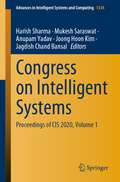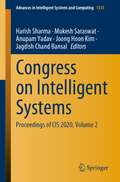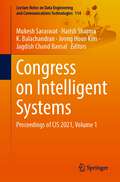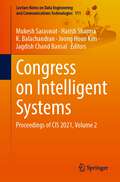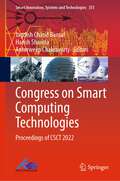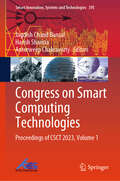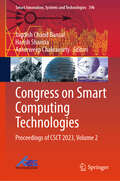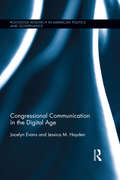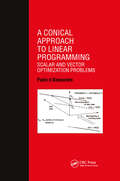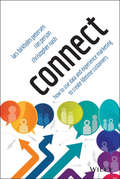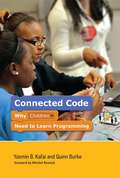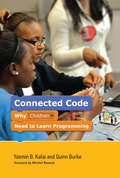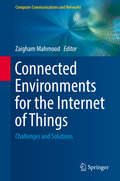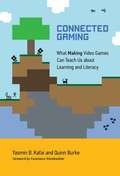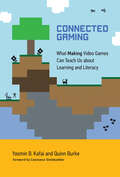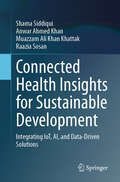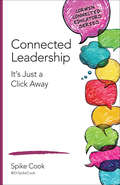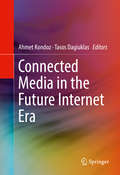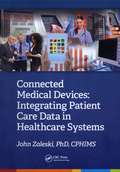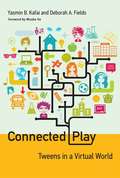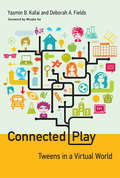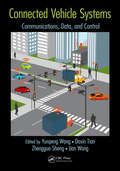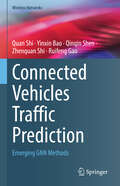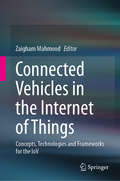- Table View
- List View
Congress on Intelligent Systems: Proceedings of CIS 2020, Volume 1 (Advances in Intelligent Systems and Computing #1334)
by Anupam Yadav Jagdish Chand Bansal Joong Hoon Kim Harish Sharma Mukesh SaraswatThis book is a collection of selected papers presented at the First Congress on Intelligent Systems (CIS 2020), held in New Delhi, India during September 5 – 6, 2020. It includes novel and innovative work from experts, practitioners, scientists and decision-makers from academia and industry. It covers topics such as Internet of Things, information security, embedded systems, real-time systems, cloud computing, big data analysis, quantum computing, automation systems, bio-inspired intelligence, cognitive systems, cyber physical systems, data analytics, data/web mining, data science, intelligence for security, intelligent decision making systems, intelligent information processing, intelligent transportation, artificial intelligence for machine vision, imaging sensors technology, image segmentation, convolutional neural network, image/video classification, soft computing for machine vision, pattern recognition, human computer interaction, robotic devices and systems, autonomous vehicles, intelligent control systems, human motor control, game playing, evolutionary algorithms, swarm optimization, neural network, deep learning, supervised learning, unsupervised learning, fuzzy logic, rough sets, computational optimization, and neuro fuzzy systems.
Congress on Intelligent Systems: Proceedings of CIS 2020, Volume 2 (Advances in Intelligent Systems and Computing #1335)
by Anupam Yadav Jagdish Chand Bansal Joong Hoon Kim Harish Sharma Mukesh SaraswatThis book is a collection of selected papers presented at the First Congress on Intelligent Systems (CIS 2020), held in New Delhi, India, during September 5–6, 2020. It includes novel and innovative work from experts, practitioners, scientists, and decision-makers from academia and industry. It covers topics such as Internet of Things, information security, embedded systems, real-time systems, cloud computing, big data analysis, quantum computing, automation systems, bio-inspired intelligence, cognitive systems, cyber physical systems, data analytics, data/web mining, data science, intelligence for security, intelligent decision making systems, intelligent information processing, intelligent transportation, artificial intelligence for machine vision, imaging sensors technology, image segmentation, convolutional neural network, image/video classification, soft computing for machine vision, pattern recognition, human–computer interaction, robotic devices and systems, autonomous vehicles, intelligent control systems, human motor control, game playing, evolutionary algorithms, swarm optimization, neural network, deep learning, supervised learning, unsupervised learning, fuzzy logic, rough sets, computational optimization, and neuro-fuzzy systems.
Congress on Intelligent Systems: Proceedings of CIS 2021, Volume 1 (Lecture Notes on Data Engineering and Communications Technologies #114)
by K. Balachandran Jagdish Chand Bansal Joong Hoon Kim Harish Sharma Mukesh SaraswatThis book is a collection of selected papers presented at the Second Congress on Intelligent Systems (CIS 2021), organized by Soft Computing Research Society and CHRIST (Deemed to be University), Bengaluru, India, during September 4 – 5, 2021. It includes novel and innovative work from experts, practitioners, scientists, and decision-makers from academia and industry. It covers topics such as Internet of things, information security, embedded systems, real-time systems, cloud computing, big data analysis, quantum computing, automation systems, bio-inspired intelligence, cognitive systems, cyber physical systems, data analytics, data/web mining, data science, intelligence for security, intelligent decision making systems, intelligent information processing, intelligent transportation, artificial intelligence for machine vision, imaging sensors technology, image segmentation, convolutional neural network, image/video classification, soft computing for machine vision, pattern recognition, human–computer interaction, robotic devices and systems, autonomous vehicles, intelligent control systems, human motor control, game playing, evolutionary algorithms, swarm optimization, neural network, deep learning, supervised learning, unsupervised learning, fuzzy logic, rough sets, computational optimization, and neuro-fuzzy systems.
Congress on Intelligent Systems: Proceedings of CIS 2021, Volume 2 (Lecture Notes on Data Engineering and Communications Technologies #111)
by K. Balachandran Jagdish Chand Bansal Joong Hoon Kim Harish Sharma Mukesh SaraswatThis book is a collection of selected papers presented at the Second Congress on Intelligent Systems (CIS 2021), organized by Soft Computing Research Society and CHRIST (Deemed to be University), Bengaluru, India during September 4 – 5, 2021. It includes novel and innovative work from experts, practitioners, scientists and decision-makers from academia and industry. It covers topics such as Internet of Things, information security, embedded systems, real-time systems, cloud computing, big data analysis, quantum computing, automation systems, bio-inspired intelligence, cognitive systems, cyber physical systems, data analytics, data/web mining, data science, intelligence for security, intelligent decision making systems, intelligent information processing, intelligent transportation, artificial intelligence for machine vision, imaging sensors technology, image segmentation, convolutional neural network, image/video classification, soft computing for machine vision, pattern recognition, human computer interaction, robotic devices and systems, autonomous vehicles, intelligent control systems, human motor control, game playing, evolutionary algorithms, swarm optimization, neural network, deep learning, supervised learning, unsupervised learning, fuzzy logic, rough sets, computational optimization, and neuro fuzzy systems.
Congress on Smart Computing Technologies: Proceedings of CSCT 2022 (Smart Innovation, Systems and Technologies #351)
by Jagdish Chand Bansal Harish Sharma Antorweep ChakravortyThis book presents high-quality research papers presented at Congress on Smart Computing Technologies (CSCT 2022) organized by SAU Center for Research and Innovative Learning (SCRIL), South Asian University, India, from 3–4 December 2022. The book extensively covers recent research in algorithms for smart computing, AI and machine learning in smart computing, edge computing algorithms, adversarial networks and autoencoders, data visualization, data mining, data analytics, machine learning, game theory, high-performance computing, mobile and ubiquitous platforms for smart environments, cloud/edge/fog computing technologies for smart systems, Internet of Things (IoT) and industrial IoT technologies for smart systems, smart device and hardware, security, privacy, and economics in smart environments, big data, healthcare informatics, smart precision agriculture, smart transportation, social network analysis, and human–computer interaction.
Congress on Smart Computing Technologies: Proceedings of CSCT 2023, Volume 1 (Smart Innovation, Systems and Technologies #395)
by Jagdish Chand Bansal Harish Sharma Antorweep ChakravortyThis book presents high-quality research papers presented at Congress on Smart Computing Technologies (CSCT 2023) organized by SAU Center for Research and Innovative Learning (SCRIL), South Asian University, India, from 2–3 December 2023. The book extensively covers recent research in algorithms for smart computing, AI and machine learning in smart computing, edge computing algorithms, adversarial networks and autoencoders, data visualization, data mining, data analytics, machine learning, game theory, high-performance computing, mobile and ubiquitous platforms for smart environments, cloud/edge/fog computing technologies for smart systems, Internet of Things (IoT) and industrial IoT technologies for smart systems, smart device and hardware, security, privacy, and economics in smart environments, big data, healthcare informatics, smart precision agriculture, smart transportation, social network analysis, and human–computer interaction. The work is presented in two volumes.
Congress on Smart Computing Technologies: Proceedings of CSCT 2023, Volume 2 (Smart Innovation, Systems and Technologies #396)
by Jagdish Chand Bansal Harish Sharma Antorweep ChakravortyThis book presents high-quality research papers presented at Congress on Smart Computing Technologies (CSCT 2023) organized by SAU Center for Research and Innovative Learning (SCRIL), South Asian University, India, from 2–3 December 2023. The book extensively covers recent research in algorithms for smart computing, AI and machine learning in smart computing, edge computing algorithms, adversarial networks and autoencoders, data visualization, data mining, data analytics, machine learning, game theory, high-performance computing, mobile and ubiquitous platforms for smart environments, cloud/edge/fog computing technologies for smart systems, Internet of Things (IoT) and industrial IoT technologies for smart systems, smart device and hardware, security, privacy, and economics in smart environments, big data, healthcare informatics, smart precision agriculture, smart transportation, social network analysis, and human–computer interaction. The work is presented in two volumes.
Congressional Communication in the Digital Age (Routledge Research in American Politics and Governance)
by Jocelyn Evans Jessica M. HaydenCommunication defines political representation. At the core of the representational relationship lies the interaction between principal and agent; the quality of this relationship is predicated upon the accessibility of effective channels of communication between the constituent and representative. Over the past decade, congressional websites have become the primary way constituents communicate with their members and a prominent place for members to communicate with constituents. Yet, as we move toward the third decade of the 21st century, little work has systematically analyzed this forum as a distinct representational space. In this book, Jocelyn Evans and Jessica Hayden offer a fresh, timely, and mixed-methods approach for understanding how the emergence of virtual offices has changed the representational relationship between constituents and members of Congress. Utilizing strong theoretical foundations, a broad historical perspective, elite interviews, and rich original datasets, Evans and Hayden present evidence that virtual offices operate as a distinct representational space, and they demonstrate that their use has resulted in unprecedented and ill-understood changes in representational behavior. Congressional Communication in the Digital Age contributes to the scholarship on representation theory and its application to the contemporary Congress. It is valuable reading for students and researchers interested in American politics, political communication, and legislative politics.
Conical Approach to Linear Programming
by P D'AlessandroThe conical approach provides a geometrical understanding of optimization and is a powerful research tool and useful problem-solving technique (for example, in decision support and real time control applications). Conical optimality conditions are first stated in a very general optimization framework, and then applied to linear programming. A complete theory along with primal and dual algorithms is given, and solutions and algorithms are also provided for vector and robust linear optimization. The advantages of parameter dependence of conical methods are fully discussed. In addition to numerical results, the book provides source codes and detailed documentation of a Modula-2 implementation for the main algorithms.
Connect: How to Use Data and Experience Marketing to Create Lifetime Customers
by Ron Person Lars Birkholm Petersen Christopher NashConnect and engage across channels with the new customers Connect is the ultimate marketing guide to becoming more relevant, effective, and successful within the new marketplace. Written by a team of marketing experts serving Fortune 500 brands, this book outlines the massive paradigm shift currently taking place within the industry, and provides the insight and perspective marketers need to stay on board. Readers will find guidance toward reaching a customer base that sees marketers as an unnecessary annoyance, and strategies for engaging those customers at touch points throughout the customer lifecycle. The book's scope encompasses both digital and real-life avenues, discussing the new ways of thinking and the new tools and processes that allow marketers to function in the new era where digital customer experiences are increasingly important. Marketing is undergoing a revolution to rival the impact of Gutenberg's printing press. Customers are in control, with more choice and more access than ever before, and they refuse to be "sold to" or "managed." Many marketing professionals are flailing for a new strategy while the winners are clearly jumping ahead - Connect takes readers inside the winners' world to learn the approach that's engaging the new consumer. Discover the technology and processes that allow marketers to remain relevant Craft a personal, relevant, and accessible customer journey that engages the connected customer Keep in touch throughout the customer's life cycle, both online and offline Link digital goals and metrics to business objectives for a more relevant strategy Smart marketers have moved to a higher level that achieves business objectives while increasing relevance to the customer. Connect provides readers a roadmap to this new approach, and the tools that make it work.
Connected Code
by Yasmin B. Kafai Mitchel Resnick Quinn BurkeCoding, once considered an arcane craft practiced by solitary techies, is now recognized by educators and theorists as a crucial skill, even a new literacy, for all children. Programming is often promoted in K-12 schools as a way to encourage "computational thinking" -- which has now become the umbrella term for understanding what computer science has to contribute to reasoning and communicating in an ever-increasingly digital world.In Connected Code, Yasmin Kafai and Quinn Burke argue that although computational thinking represents an excellent starting point, the broader conception of "computational participation" better captures the twenty-first-century reality. Computational participation moves beyond the individual to focus on wider social networks and a DIY culture of digital "making." Kafai and Burke describe contemporary examples of computational participation: students who code not for the sake of coding but to create games, stories, and animations to share; the emergence of youth programming communities; the practices and ethical challenges of remixing (rather than starting from scratch); and the move beyond stationary screens to programmable toys, tools, and textiles.
Connected Code: Why Children Need to Learn Programming (The John D. and Catherine T. MacArthur Foundation Series on Digital Media and Learning)
by Yasmin B. Kafai Quinn BurkeWhy every child needs to learn to code: the shift from “computational thinking” to computational participation.Coding, once considered an arcane craft practiced by solitary techies, is now recognized by educators and theorists as a crucial skill, even a new literacy, for all children. Programming is often promoted in K-12 schools as a way to encourage “computational thinking”—which has now become the umbrella term for understanding what computer science has to contribute to reasoning and communicating in an ever-increasingly digital world.In Connected Code, Yasmin Kafai and Quinn Burke argue that although computational thinking represents an excellent starting point, the broader conception of “computational participation” better captures the twenty-first-century reality. Computational participation moves beyond the individual to focus on wider social networks and a DIY culture of digital “making.”Kafai and Burke describe contemporary examples of computational participation: students who code not for the sake of coding but to create games, stories, and animations to share; the emergence of youth programming communities; the practices and ethical challenges of remixing (rather than starting from scratch); and the move beyond stationary screens to programmable toys, tools, and textiles.
Connected Environments for the Internet of Things: Challenges and Solutions (Computer Communications and Networks)
by Zaigham MahmoodThis comprehensive text/reference presents a broad-ranging overview of device connectivity in distributed computing environments, supporting the vision of an Internet of Things (IoT). Expert perspectives are provided by an international selection of researchers from both industry and academia, covering issues of communication, security, privacy, interoperability, networking, access control, and authentication. In addition to discussing state-of-the-art research and practice, the book includes corporate analyses offering a balanced view of benefits and limitations, and numerous case studies illustrating the challenges and practical solutions. Topics and features: discusses issues of security and privacy in connected environments, with a specific focus on the impact of the IoT paradigm on enterprise information systems; examines the challenges of managing big data in IoT environments, and proposes cloud computing-based solutions to the limitations inherent in the IoT paradigm; suggests approaches to overcome service-level interoperability problems in the IoT environment; introduces a mobile IoT simulator designed to evaluate the behavior of IoT systems, in addition to a novel approach to manage hyper-connectivity in the IoT; describes the use of the Essence framework to model software development methods, and highlights the benefits of integrating data from smart buildings and IoT devices; presents an asymmetric schema matching mechanism for IoT interoperability, and explores the topic of automatic provenance capture at the middleware level; reviews emerging network topologies and communication technologies, and advises on the adoption of a data distribution service as a middleware platform for IoT systems. This practically-oriented volume serves as a complete reference for students, researchers and practitioners of distributed computing, providing insights into the latest approaches, technologies, and frameworks relevant to the IoT environment.
Connected Gaming: What Making Video Games Can Teach Us about Learning and Literacy
by Constance Steinkuehler Yasmin B. Kafai Quinn BurkeOver the last decade, video games designed to teach academic content have multiplied. Students can learn about Newtonian physics from a game or prep for entry into the army. An emphasis on the instructionist approach to gaming, however, has overshadowed the constructionist approach, in which students learn by designing their own games themselves. In this book, Yasmin Kafai and Quinn Burke discuss the educational benefits of constructionist gaming -- coding, collaboration, and creativity -- and the move from "computational thinking" toward "computational participation." Kafai and Burke point to recent developments that support a shift to game making from game playing, including the game industry's acceptance, and even promotion, of "modding" and the growth of a DIY culture. Kafai and Burke show that student-designed games teach not only such technical skills as programming but also academic subjects. Making games also teaches collaboration, as students frequently work in teams to produce content and then share their games with in class or with others online. Yet Kafai and Burke don't advocate abandoning instructionist for constructionist approaches. Rather, they argue for a more comprehensive, inclusive idea of connected gaming in which both making and gaming play a part.
Connected Gaming: What Making Video Games Can Teach Us about Learning and Literacy (The John D. and Catherine T. MacArthur Foundation Series on Digital Media and Learning)
by Yasmin B. Kafai Quinn BurkeHow making and sharing video games offer educational benefits for coding, collaboration, and creativity.Over the last decade, video games designed to teach academic content have multiplied. Students can learn about Newtonian physics from a game or prep for entry into the army. An emphasis on the instructionist approach to gaming, however, has overshadowed the constructionist approach, in which students learn by designing their own games themselves. In this book, Yasmin Kafai and Quinn Burke discuss the educational benefits of constructionist gaming—coding, collaboration, and creativity—and the move from “computational thinking” toward “computational participation.” Kafai and Burke point to recent developments that support a shift to game making from game playing, including the game industry's acceptance, and even promotion, of “modding” and the growth of a DIY culture. Kafai and Burke show that student-designed games teach not only such technical skills as programming but also academic subjects. Making games also teaches collaboration, as students frequently work in teams to produce content and then share their games with in class or with others online. Yet Kafai and Burke don't advocate abandoning instructionist for constructionist approaches. Rather, they argue for a more comprehensive, inclusive idea of connected gaming in which both making and gaming play a part.
Connected Health Insights for Sustainable Development: Integrating IoT, AI, and Data-Driven Solutions
by Shama Siddiqui Anwar Ahmed Khan Muazzam Ali Khan Khattak Raazia SosanThis book offers a comprehensive look at how emerging technologies like IoT, Data Science, and AI can drive significant advancements in healthcare, particularly in alignment with Sustainable Development Goal 3 (SDG 3) – Good Health and Well-Being. By bridging technological innovation with the critical need for improved healthcare systems, this book explores how these technologies are revolutionizing both personal and population health management. Readers will gain insights into how IoT-enabled devices, AI-powered analytics, and data-driven decision-making tools enhance everything from continuous patient monitoring to personalized medicine and resource optimization for governments. The initial chapters provide a foundational understanding of IoT, AI, and Data Science, followed by in-depth discussions on their integration into healthcare applications. Key topics include continuous health monitoring through wearable technologies, the role of mobile health (m-Health) in making healthcare more accessible, and the use of advanced analytics in diagnosing diseases early. Personalized medicine is explored as a pivotal breakthrough in improving patient outcomes by leveraging data from IoT devices and AI-driven models to tailor treatment plans. Further, the book also covers the advancements in medical imaging and how it supports real-time diagnosis and treatment. Towards the latter part, the book delves into population health surveillance and healthcare resource management through the combined power of these technologies. It presents how governments and healthcare providers can optimize their resources, predict disease outbreaks, and manage pandemics more effectively. Additionally, ethical concerns surrounding the use of these technologies in healthcare are discussed, providing readers with a holistic view of both the opportunities and challenges posed by the IoT-Data Science-AI nexus in achieving SDG 3.
Connected Leadership: It’s Just a Click Away (Corwin Connected Educators Series)
by Spike C. CookYou’re at the top—but never alone! Take the leap and connect with other educators and leaders through social media. Educators learn to transform relationships with their students, staff, parents, and with the overall community in this simple guide to social media. With real-life examples from K12 educators who’ve integrated social media technology and education, this guide helps educators to harness the power of connectedness and change the way you lead. Jump in and you’ll learn how to: Develop a personal learning network Tell your school’s story through blogging Use connections to transform your leadership The Corwin Connected Educators series is your key to unlocking the greatest resource available to all educators: other educators. Being a Connected Educator is more than a set of actions: it’s a belief in the potential of technology to fuel lifelong learning. "This book has practical examples of how educators can use Web 2.0 tools to grow professionally and personally. Cook describes his journey as a lead learner in a way that is easy to read; he inspires, engages, and encourages the reader to move from isolation to connection." Dwight Carter, Principal New Albany High School "After reading this book, you′ll be inspired by the stories of newly connected educators. If you′ve been hesitant to take the plunge into the social media waters, you′ll be ready to jump right in after this quick and informative read." Erin Klein, Teacher and Blogger Kleinspiration
Connected Leadership: It’s Just a Click Away (Corwin Connected Educators Series)
by Spike C. CookYou’re at the top—but never alone! Take the leap and connect with other educators and leaders through social media. Educators learn to transform relationships with their students, staff, parents, and with the overall community in this simple guide to social media. With real-life examples from K12 educators who’ve integrated social media technology and education, this guide helps educators to harness the power of connectedness and change the way you lead. Jump in and you’ll learn how to: Develop a personal learning network Tell your school’s story through blogging Use connections to transform your leadership The Corwin Connected Educators series is your key to unlocking the greatest resource available to all educators: other educators. Being a Connected Educator is more than a set of actions: it’s a belief in the potential of technology to fuel lifelong learning. "This book has practical examples of how educators can use Web 2.0 tools to grow professionally and personally. Cook describes his journey as a lead learner in a way that is easy to read; he inspires, engages, and encourages the reader to move from isolation to connection." Dwight Carter, Principal New Albany High School "After reading this book, you′ll be inspired by the stories of newly connected educators. If you′ve been hesitant to take the plunge into the social media waters, you′ll be ready to jump right in after this quick and informative read." Erin Klein, Teacher and Blogger Kleinspiration
Connected Media in the Future Internet Era
by Ahmet Kondoz Tasos DagiuklasThis book describes recent innovations in 3D media and technologies, with coverage of 3D media capturing, processing, encoding, and adaptation, networking aspects for 3D Media, and quality of user experience (QoE). The contributions are based on the results of the FP7 European Project ROMEO, which focuses on new methods for the compression and delivery of 3D multi-view video and spatial audio, as well as the optimization of networking and compression jointly across the future Internet. The delivery of 3D media to individual users remains a highly challenging problem due to the large amount of data involved, diverse network characteristics and user terminal requirements, as well as the user's context such as their preferences and location. As the number of visual views increases, current systems will struggle to meet the demanding requirements in terms of delivery of consistent video quality to fixed and mobile users. ROMEO will present hybrid networking solutions that combine the DVB-T2 and DVB-NGH broadcast access network technologies together with a QoE aware Peer-to-Peer (P2P) distribution system that operates over wired and wireless links. Live streaming 3D media needs to be received by collaborating users at the same time or with imperceptible delay to enable them to watch together while exchanging comments as if they were all in the same location. This book is the last of a series of three annual volumes devoted to the latest results of the FP7 European Project ROMEO. The present volume provides state-of-the-art information on 3D multi-view video, spatial audio networking protocols for 3D media, P2P 3D media streaming, and 3D Media delivery across heterogeneous wireless networks among other topics. Graduate students and professionals in electrical engineering and computer science with an interest in 3D Future Internet Media will find this volume to be essential reading.
Connected Medical Devices: Integrating Patient Care Data in Healthcare Systems (HIMSS Book Series)
by John ZaleskiThis book explores how medical device integration (MDI) supports quality patient care and better clinical outcomes by reducing clinical documentation transcription errors, improving data accuracy and density within clinical records and ensuring the complete capture of medical device information on patients. It begins with a comprehensive overview of the types of medical devices in use and the ways in which those devices interact, then examines factors such as interoperability standards, patient identification, clinical alerts and regulatory and security considerations.
Connected Play: Tweens in a Virtual World
by Yasmin B. Kafai Deborah A. FieldsMillions of children visit virtual worlds every day. In such virtual play spaces as Habbo Hotel, Toontown, and Whyville, kids chat with friends from school, meet new people, construct avatars, and earn and spend virtual currency. In "Connected Play," Yasmin Kafai and Deborah Fields investigate what happens when kids play in virtual worlds, how this matters for their offline lives, and what this means for the design of educational opportunities in digital worlds. Play is fundamentally important for kids development, but, Kafai and Fields argue, to understand play in virtual worlds, we need to connect concerns of development and culture with those of digital media and learning. Kafai and Fields do this through a detailed study of kids play in Whyville, a massive, informal virtual world with educational content for tween players. Combining ethnographic accounts with analysis of logfile data, they present rich portraits and overviews of how kids learn to play in a digital domain, developing certain technological competencies; how kids learn to play well -- responsibly, respectfully, and safely; and how kids learn to play creatively, creating content that becomes a part of the virtual world itself.
Connected Play: Tweens in a Virtual World (The John D. and Catherine T. MacArthur Foundation Series on Digital Media and Learning)
by Yasmin B. Kafai Deborah A. FieldsHow kids play in virtual worlds, how it matters for their offline lives, and what this means for designing educational opportunities.Millions of children visit virtual worlds every day. In such virtual play spaces as Habbo Hotel, Toontown, and Whyville, kids chat with friends from school, meet new people, construct avatars, and earn and spend virtual currency. In Connected Play, Yasmin Kafai and Deborah Fields investigate what happens when kids play in virtual worlds, how this matters for their offline lives, and what this means for the design of educational opportunities in digital worlds. Play is fundamentally important for kids' development, but, Kafai and Fields argue, to understand play in virtual worlds, we need to connect concerns of development and culture with those of digital media and learning. Kafai and Fields do this through a detailed study of kids' play in Whyville, a massive, informal virtual world with educational content for tween players. Combining ethnographic accounts with analysis of logfile data, they present rich portraits and overviews of how kids learn to play in a digital domain, developing certain technological competencies; how kids learn to play well—responsibly, respectfully, and safely; and how kids learn to play creatively, creating content that becomes a part of the virtual world itself.
Connected Vehicle Systems: Communication, Data, and Control
by Zhengguo Sheng Yunpeng Wang Daxin Tian Wang JianConnected vehicles and intelligent vehicles have been identified as key technologies for increasing road safety and transport efficiency. This book presents and discusss the recent advances in theory and practice in connected vehicle systems. It covers emerging research that aims at dealing with the challenges in designing the essential functional components of connected vehicles. Major topics include intra- and inter-vehicle communications, mobility model of fleet and ramp merging, trace and position data analysis, security and privacy.
Connected Vehicles Traffic Prediction: Emerging GNN Methods (Wireless Networks)
by Quan Shi Yinxin Bao Qinqin Shen Zhenquan Shi Ruifeng GaoThis book delves into the problems and challenges faced in achieving improved performance in connected vehicles traffic flow prediction in intelligent connected transportation systems and provides an in-depth analysis of spatial-temporal feature extraction, global local spatial feature extraction, and fusion of external factors. The book is divided into ten chapters, and the introductory section presents the history of the development of artificial intelligence and graph neural networks in the context of connected vehicles, related work on prediction of connected traffic, and preliminary knowledge. Chapter 2 to 9 present eight prediction methods in the context of connected traffic, respectively. Each section includes an introduction to the problem definition, model architecture, experimental setup, and discussion of results, as well as references. The last section summarizes the contributions of the book and future challenges.
Connected Vehicles in the Internet of Things: Concepts, Technologies and Frameworks for the IoV
by Zaigham MahmoodThis book presents an overview of the latest smart transportation systems, IoV connectivity frameworks, issues of security and safety in VANETs, future developments in the IoV, technical solutions to address key challenges, and other related topics. A connected vehicle is a vehicle equipped with Internet access and wireless LAN, which allows the sharing of data through various devices, inside as well as outside the vehicle. The ad-hoc network of such vehicles, often referred to as VANET or the Internet of vehicles (IoV), is an application of IoT technology, and may be regarded as an integration of three types of networks: inter-vehicle, intra-vehicle, and vehicular mobile networks. VANET involves several varieties of vehicle connectivity mechanisms, including vehicle-to-infrastructure (V2I), vehicle-to-vehicle (V2V), vehicle-to-cloud (V2C), and vehicle-to-everything (V2X). According to one survey, it is expected that there will be approximately 380 million connected cars on the roads by 2020. IoV is an important aspect of the new vision for smart transportation. The book is divided into three parts: examining the evolution of IoV (basic concepts, principles, technologies, and architectures), connectivity of vehicles in the IoT (protocols, frameworks, and methodologies), connected vehicle environments and advanced topics in VANETs (security and safety issues, autonomous operations, machine learning, sensor technology, and AI). By providing scientific contributions and workable suggestions from researchers and practitioners in the areas of IoT, IoV, and security, this valuable reference aims to extend the body of existing knowledge.
